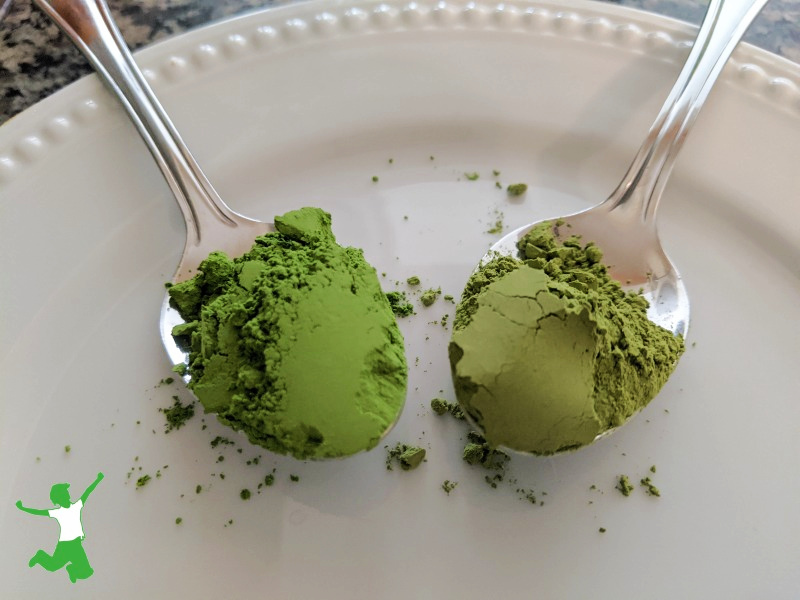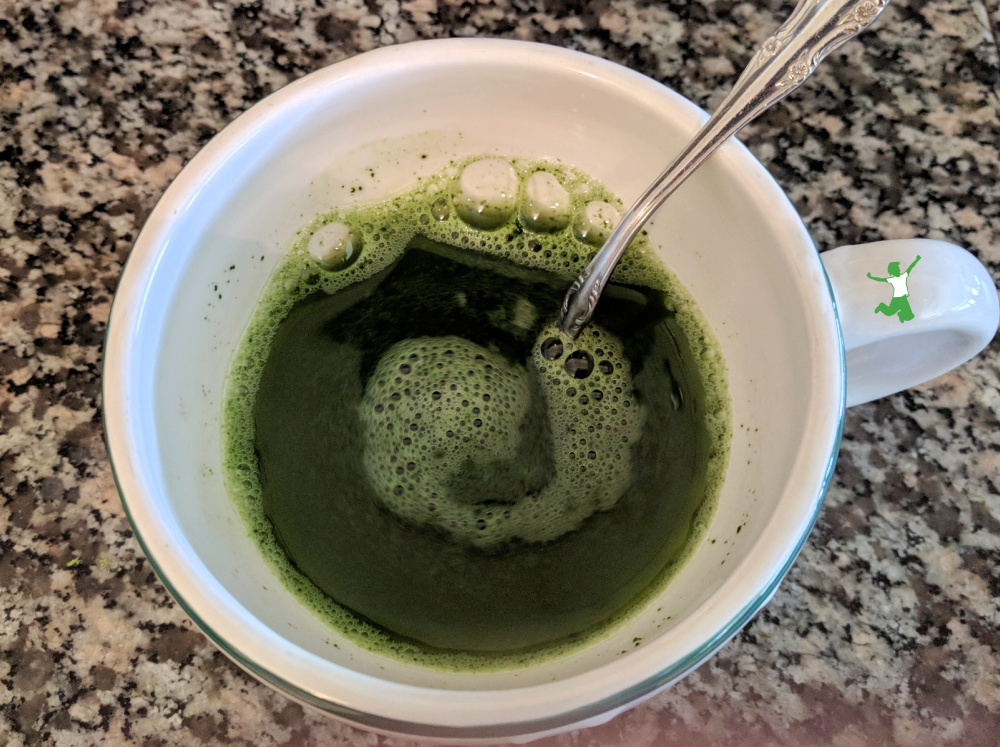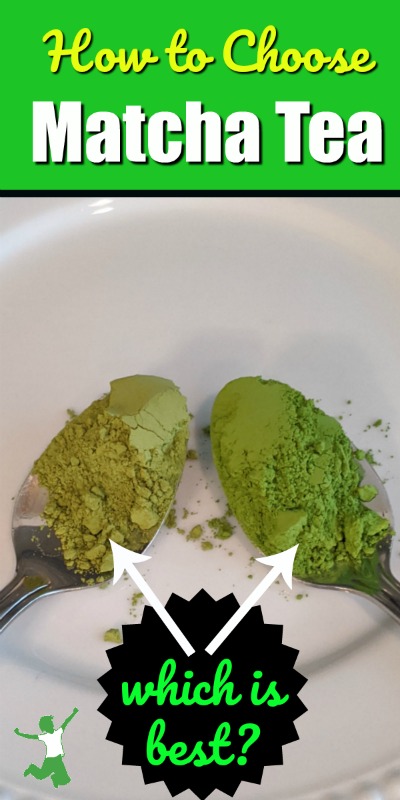Table of Contents[Hide][Show]
- The Origins of Green Tea Powder
- The Making of True Matcha
- Specialized Growing
- Hand Processing
- How Green Tea Powder (not Matcha) is Made
- Conditions for Producing Authentic Matcha
- How Much Does Matcha Cost?
- Matcha vs Green Tea Powder Benefits
- Is Matcha a Superfood?
- Regular vs Decaf
- Green Tea Powder Concerns
- Consuming Matcha Safely
Green tea powder has many health benefits but be aware that not all versions can be considered Matcha, the ancient beverage of Japan. What to look for to get the real thing that is safe and free from contaminants.

An ancient beverage made with green tea powder is rapidly making inroads within the coffee community.
Called matcha in trendy circles, this new “it” beverage is made by sifting a small amount of specially made green tea powder into a cup and then whisking with hot water.
Smaller amounts of water can be used to make stronger matcha shots. The process is similar to what is commonly done with yerba mate (maté), green tea’s South American cousin.
A typical cup of matcha tea is made with one teaspoon of Japanese green tea powder per 4-6 ounces (113-170 grams) of hot water.
It contains approximately 70 mg of caffeine per cup, nearly three times the amount of steeped green tea and slightly lower than a cup of coffee or maté.
Matcha fans cite the higher level of beneficial antioxidants in green tea powder versus steeped green tea leaves.
In addition, the noticeable calming effect of the amino acid L-theanine slows the absorption of caffeine, extending matcha’s famed “calm but alert” period.
L-theanine is conspicuously absent in coffee and maté, which may be why they can cause the jitters for some people.
Even though the effect of caffeine is significantly muted when consuming a cup of matcha, this isn’t a free pass to jump right in.
There are important considerations to be made concerning the processing of green tea powder before deciding to enjoy a cup. Here’s what you need to know to ensure that your matcha measures up!
The Origins of Green Tea Powder
The popularity of using green tea powder to make tea has roots in the Tang Dynasty in China which dates back to the seventh century AD.
During that time, tea leaves were steamed and formed into small bricks that were stored or traded. Tea was prepared by roasting and then pulverizing the tea into powder. The powder was mixed with hot water and a bit of salt for drinking. (1)
Powdered tea was used as part of rituals by Chan or Zen Buddhists in China. In 1191 AD, was brought to Japan by the monk Eisai.
Several centuries later in the Song Dynasty in Japan, the method of preparing green powdered tea was perfected.
The process involved whipping the tea powder and hot water together into a froth using bamboo whisks in an oversized bowl called a chawan.
During this time, matcha became an important ritualized part of the country’s Zen monasteries and was appreciated by the educated members of society.
True matcha tea is of Japanese origin only.
Many other brands with different countries of origin choose to falsely label their green tea powder as matcha, however.
The Japanese have exacting standards for matcha cultivation and manufacture, which is why matcha is still Japan’s most expensive tea.
The Making of True Matcha
Today much of the green tea powder on the market is grown and processed in a manner quite different from true matcha.
Unfortunately, these green tea powders are frequently labeled as matcha when in fact they are not true matcha at all.
Buyer beware!
I’ve summarized the key points of how true matcha is made below. (2)
Specialized Growing
Authentic matcha is made from tea leaves that are shaded from direct sunlight. The structure used is called a tana.
Tea plants destined for matcha are shaded several weeks before harvest. This slows growth resulting in long slender leaves and weak stems. It also stimulates the production of detoxifying chlorophyll.
The increased levels of chlorophyll cause the tea leaves to become a darker shade of green.
The amino acid levels in the tea also increase significantly, particularly L-theanine, the amino acid that slows caffeine absorption and is responsible for matcha’s reputation for bestowing a calm sense of alertness.
The higher percentage of amino acids in true matcha tea is why it is naturally sweeter and creamier on the tongue.
Hand Processing
When ready for harvest, only the finest tea leaves are hand-picked for matcha. The carefully selected leaves are quickly steamed and then air-dried.
The drying process occurs on a flat surface to maintain the shape of the leaves. When complete, the veins and stems of the leaves are removed.
Note that matcha is never rolled, pressed, or shaped like other teas. Finally, the dried leaves are stoneground with granite millstones to a very fine, bright green powder.
The grinding process for producing matcha is extremely slow.
A mere 30 grams of matcha sometimes takes as long as an hour to produce!
Milling temporarily stops when the stones get too warm. This is because grinding the tea using hot stones negatively affects the aroma and flavor.
Properly made matcha is never grassy or bitter. It is creamy, silky and full-bodied.
It is truly in a class of its own compared to other forms of green tea you may have tried.
How Green Tea Powder (not Matcha) is Made
Not surprisingly, the popularity and trendiness of the word matcha has caused a marketing free for all in the world of tea.
However, it is important for tea lovers to know that most green tea powder on the market is not true matcha.
How to tell?
For one, if your green tea powder does not come from Japan, it is not matcha.
Authentic matcha requires the special geography, latitude, climate, weather patterns, and soil of the Japanese islands.
These conditions are not easily reproduced anywhere else.
Similarly, authentic balsamic vinegar only comes from the areas surrounding Modena, Italy which has the specific terroir required to produce and age it.
Conditions for Producing Authentic Matcha
Even if green tea powder comes from Japan, it still might not be authentic!
These conditions must be present for matcha quality and authenticity:
- The tea plants are shaded for a full 20-30 days prior to harvest to ensure the highest chlorophyll levels possible.
- No use of any machinery to harvest the tea leaves. Hand harvest only!
- The leaves are carefully de-stemmed and de-veined before grinding.
- The leaves are stoneground by hand and the process is stopped when the stones get too warm, restarting only when the stones are cool again.
Of course, freshness is an important consideration too.
Depending on the month of the year your purchase is made, matcha should be from the current or previous harvest only.
How Much Does Matcha Cost?
Note that authentic matcha (brand I use) costs about $1+ per serving if you prepare a clump-free cup yourself at home.
It also costs more than a cup of steeped green tea in a café.
Green tea powder brands that cost significantly less are probably not true matcha.
For this reason, I personally never order matcha in a café because I don’t know if it is authentic or whether the brand used is even safe.
Dirt-cheap brands should be considered a contamination risk as well. This is discussed in further detail below.
Matcha vs Green Tea Powder Benefits
The word “matcha” literally means powdered tea. When you drink a cup of matcha, that is exactly what you are consuming.
As described above, green tea powder is made by grinding whole tea leaves into a fine powder. This manufacturing process may or may not be of high quality.
The powder is then mixed with hot water and consumed. With a cup of regular green tea, only the components of the tea are ingested as the tea leaves are steeped in hot water and then discarded.
Consuming the entire tea leaf via green tea powder has many benefits. This is especially true when matcha, the highest quality green tea powder is consumed.
The biggest benefit to consuming green tea in powder form is the megadoses of antioxidants.
It is estimated that one cup of tea made with green tea powder delivers 10 times the antioxidants of a single cup of brewed green tea.
Given that matcha tea is more carefully grown and harvested to maintain nutrient value, the antioxidant value may be even higher.
Perhaps this is one reason why matcha green tea is effective at eliminating headaches for those who don’t consume caffeine as a regular habit.
Is Matcha a Superfood?
Lab analysis at Tufts University of properly made matcha tea suggests that a single cup is higher in antioxidants than one serving of all these superfoods combined: (3)
- Goji berries
- Spinach
- Pomegranate
- Blueberries
- Acai berries
- Broccoli
The most abundant natural phenol and antioxidant in green tea is epigallocatechin gallate (EGCG).
A cup of matcha tea contains 3 times the EGCG as a cup of regular green tea.
Due to the abundant research on this catechin, the Journal of the American College of Nutrition considers green tea to be a useful food for the maintenance of cardiovascular and metabolic health. (4)
Before you run out and buy a jar of matcha tea, however, note this important consumer warning.
Regular vs Decaf
If you are sensitive to caffeine but wish to enjoy the antioxidant benefits of matcha, I recommend decaf instead.
There aren’t many brands of decaf matcha on the market. Whichever one you choose, be sure it is:
- Organic
- Ceremonial grade (first harvest)
- Japanese origin
- Decaffeinated using the water method rather than chemicals
One-half teaspoon of decaf matcha contains 2 mg caffeine compared to regular matcha which contains 35 mg caffeine.
So, while decaf matcha is not caffeine-free, the amount is fairly negligible unless you are super sensitive.

Green Tea Powder Concerns
The carefully outlined differences above between authentic matcha tea and run-of-the-mill green tea powder are extremely important to note and not just because true matcha tea is likely much higher in antioxidants.
As it turns out, authentic matcha tea (brand suggestion) produced in Japan using traditional methods is much safer too.
For example, knock-off matcha from China was found by the research organization ConsumerLab to contain excessive amounts of lead. (5)
No detectable lead was found in green tea produced in Japan, however. The highest quality matcha comes from Japan’s southern regions: Kyushu, Nishio, Shizuoka, and Uji.
Interestingly, matcha tests from other countries came back with no detectable levels of heavy metals including lead, cadmium, and arsenic.
Note that fluoride levels were not tested so results are not conclusive with regard to safety.
Brands of matcha products tested were DöMatcha, Kirkland Signature (Costco), Rishi, Teavana, and The Republic of Tea. (6)
Out of an abundance of caution, ConsumerLab recommends against serving a beverage made with green tea powder to children.
Consuming Matcha Safely
It seems that the safest way to consume green tea powder is to stick with brands where the country of origin is Japan.
Green tea grown in this part of the world consistently tests clean whether the tea was destined for brewing or matcha purposes.
The matcha I trust (source) comes straight from the pristine tea plantations of Nishio, Japan.
Nishio teas are laboratory tested to ensure a product that is free from radiation, heavy metals, and other toxins including fluoride.
I usually blend it with milk to make a creamy matcha latte or an iced matcha frappe.
This article on using matcha in the kitchen describes several other ways to enjoy the antioxidant benefits.
I don’t drink matcha often, but when I do, I enjoy it at home ONLY to make sure it is from the cleanest source possible.
Hence, as mentioned earlier, I do not order matcha at cafés or other places where the source is unknown.
Tea made with green tea powder that was grown in toxic soil can undo the many benefits of matcha, such an amazing traditional beverage!
When it comes to matcha-making, it is worth the effort to be discriminating.

(1) Chanoyu Quarterly No. 32 (Tea and the Arts of Japan)
(2) Will the Real Matcha Please Stand Up
(3) Health Benefits of Matcha Tea
(4) Effects of green tea and EGCG on cardiovascular and metabolic health
(5) Green Tea Review: Tea Bags, Matcha Powders, and Supplements
(6) Is Matcha a Better Form of Green Tea? ConsumerLab.com Answers the Question








The recommended matcha is still out of stock all these years later – I am curious if you have a new recommendation. Thank you so much.
Thanks for the heads up. That link is fixed now. Here it is for your convenience. https://www.thehealthyhomeeconomist.com/go/matcha
Sarah, the brand you recommend of currently out of stock and future availability is unknown. Is there another brand you might recommend? I have been getting the one Costco was carrying but they have stopped carrying it.
I don’t have another brand to recommend at this time. I am waiting to reorder as well! I will let you know if I find something else that is the same quality.
I wish someone would recommend authentic BRANDS of matcha.. so easy to be ripped off ! Please name some brands to buty and not to buy
The articles does recommend a brand. https://www.thehealthyhomeeconomist.com/go/matcha/
Matcha is awesome in smoothies and desserts 😀
Try frozen bananas, matcha powder, pistachios, vanilla and milk of choice. And if you need it a bit sweeter, add either a date or honey (your choice).
Love your blog btw, it looks great 🙂
What age kids can have matcha? And is it safe for them to have the matcha frappaccino from Starbucks?
I don’t think it is wise to give children drinks that are high in caffeine. Frappaccinos from Starbucks are very high in GMO sugar too .. ugh.
This looks delicious…..Thank you for sharing this information with us
Thank you so much for posting this! I’m a long time lurker but I had to
sign up to comment and let you know how much I enjoyed this,
I even shared it to facebook! Keep up the good work!
Great article Sarah, I’ve been wondering about matcha tea since reading on another Facebook that a woman had severe arthritis and drinking this tea allowed her to get off all her drugs. Can you put this in protein drinks?
Best to mix with hot water and drink that way as done traditionally. But yes, you can add it to other foods.
You are not concerned after Fukushima disaster?
Not at all. Fukushima primarily affects the Pacific ocean not the soil far away in southern Japan. The matcha I buy is grown in southern Japan is tested for radiation, fluoride and heavy metals and is free from all of this.
Hello so which brands out of those tested are safe? I’ve been drinking Teavana’s matcha for 3-4 years now every morning and already have health issues so this is a great article for me. I do have some cognition problems so perhaps o missed it on the article. Also which brand is your favorite?
The tested brands are listed in the article, however, fluoride levels were not tested only heavy metals. The brand I use which is tested for everything (radiation, fluoride, heavy metals) is Royal Matcha http://amzn.to/2dn3aMp